Lego bricks in the making
Обновлено: 03.05.2024
There is quite a bit more that goes into manufacturing rectangular bricks of plastic than you would initially think.
While certainly not as complex as many of the plastic components made for car interiors or high-end consumer products, LEGO bricks are extremely well engineered. The closer you look, the more details you start to notice about how much has gone into making these foot-destroying little monsters one of the highest quality products manufactured across any industry.
Let’s break down the design a bit and see just what they’ve done to perfect the plastic brick.
Perfecting the Basics
Plastic part design starts by setting the thickness of the part. It’s hugely important and often difficult decision as the wall thickness is a balance between several factors:
Strength: The thicker the wall, the stronger each brick will be. They’re good on this front — the BBC reports that an average LEGO brick can support 950 pounds, equating to a tower more than 2 miles high before the bottom brick collapses.
Dimensional stability (i.e. will it warp?): Injection molded products are somewhat counter-intuitive as thinner walls are typically less likely to warp out of shape. This is incredibly important as warped bricks would not snap together in trademark LEGO fashion.
Manufacturability: Make the walls too thin and you need, quite literally, tons more pressure to fill the mold while also creating high-levels of stress as the melted plastic fills the mold that can lead to molded in stress and degradation.
Cost: LEGO makes 19 billion elements each year, so shaving off even a fraction of the wall thickness would result in massive cost savings.

For the DUPLO brick we’re looking at, the sides are 1.5mm thick — very close to the minimum recommended wall thickness for the ABS (acrylonitrile butadiene styrene) plastic used. What’s interesting is that the top face is only 1mm thick which is well below the standard guideline for ABS, but is done for a very good reason that we’ll explain next…
Perfectly Straight Walls
One of the biggest challenges when injection molding non-circular shapes is getting plastic to corners of the part at the same time as everything else. If this doesn’t happen the part will not shrink uniformly and each side of the part will bow in or out causing problems snapping bricks together.

The left image shows a model using flow leaders and the right is a uniform 1.5mm thickness. Notice how the flow accelerates through the flow leaders helping the plastic reach the corners at the same time as the rest of the wall.
LEGO solved this issue by using a combination of reduced thickness (as explained above) and flow leaders on the underside of the horizontal wall. The raised paths start from the center of the part where the plastic is injected and travel first to the bosses and then to the corners of the part. As the plastic flows through the mold it follows the path of least resistance, travelling through these paths faster so the corners fill at exactly the same time as the shorter walls. This results in a uniform rate of shrinkage as the plastic cools so the walls remain flat.
This approach does not work for the long walls of the 2x4 DUPLO brick as the middle fills with plastic well before the corners. So it is supported by a rib that prevents them from bowing inwards both due to shrinkage as well as in use by kids with abnormally strong hands (and possibly 35 year old children).
A Perfect Stack
A box with straight sides is just the first step in making sure every brick stacks together just right. Across the part, the surface is completely free from any marks or defects except one location — the spot right in the middle of the top surface where the plastic is injected into the mold. That’s what’s called ‘gate vestige’. It’s a necessary evil that has to be dealt with and LEGO does so in a wonderfully simple way. They dented it. That is, they created a small circular impression so that they don’t have to deal with the little nib of plastic after it comes out of the mold. It just sits below the top surface of the part so blocks can be stacked evenly and there’s no post-molding operation required to clean it up.

Another necessary element of injection molding is the need to add draft to the side walls so that the part can be easily ejected from the mold. However, this would result in a slight overhang when stacking blocks on top of each other as the bottom would be slightly larger than the top of the brick below. For most manufacturers this would not even register as a problem…but we’re talking about the perfect brick. LEGO moved the parting line up about 1mm above the bottom edge of the part, so the wall tapers back in and a rounded edge is added to give the appearance that it is the same dimension, creating a seamless transition from one brick to the next.

One last detail that ensures a perfect stack can be found on the bosses underneath. The bosses and the ribs are arranged to accept the posts on the top of the brick below. If you look closely at the bosses, you’ll notice that the wall is reinforced at each spot where the post will contact it. This is just another subtle detail that, according to LEGO enthusiast Phillipe Cantin and his custom built LEGO test contraption, allow the bricks to be assembled 37,111 times before they wear out.
Perfectly Manufactured
To support the volume of bricks made each year the manufacturing process has to be dialed in so manual intervention is rarely, if ever, necessary.
So they needed to find a way to deal with the features of LEGO bricks that make getting them out of the mold a bit of a trick. When the posts on the top of the part cool down and shrink, they are likely going to ‘stick’ to the pins coming out of the mold that form them. The result is a part that can attach itself to the wrong side of the mold when it opens so it can’t be automatically removed.

Another simple fix. Between the small ribs on the inside of the part there are small extrusions that come out about a tenth of a millimeter from the wall. These are there solely to grip the part when the mold opens so it stays on the right side of the tool.
But with a very minimal draft angle and the ‘grippers’ on the part, more force is now required to eject the part while still making sure it isn’t damaged. Rather than using ejector pins that would apply force to the thin horizontal wall, LEGO uses three ejector sleeves on the base of each of the bosses that apply the ejection force to the strongest structural feature of the part.
The Perfect Brick
There’s clearly a lot of engineering that has gone into these…and we’re still only examining what is visible on the part itself. You can be certain that just as much effort has gone into engineering the material to get the exact mechanical and manufacturing properties they require, designing the mold to achieve the highest quality part with the shortest cycle time possible, and setting up a robust manufacturing process that can be replicated at manufacturing sites across multiple continents.
The question of how easy it is to design and manufacture something is not always based on the obvious simplicity or complexity of the object. You also have to account for the standard of quality and how close one gets to the absolute best possible design.
Inspire LEGO® builders to get creative with these easy-to-follow building instructions! Just scroll down to find your LEGO Classic box, then click on a model to download free building instructions. A great way to get kids building – and a great way for you to share the fun!
11001 LEGO® Bricks and Ideas
Introduce budding builders to LEGO® Classic with an awesome dinosaur toy, colorful keyboard, cute house and a push-along steam train. Once the free building instructions get kids started, the creative construction and imaginative play will never stop!

Classic - Product - 11002 LEGO® Basic Brick Set
Spark kids’ imaginations with free building instructions for these cool, creative, quick-build LEGO® models. From a dog with a bone to a knight on a horse, a monster truck to a dinosaur toy – anything is possible when you know how it’s done.
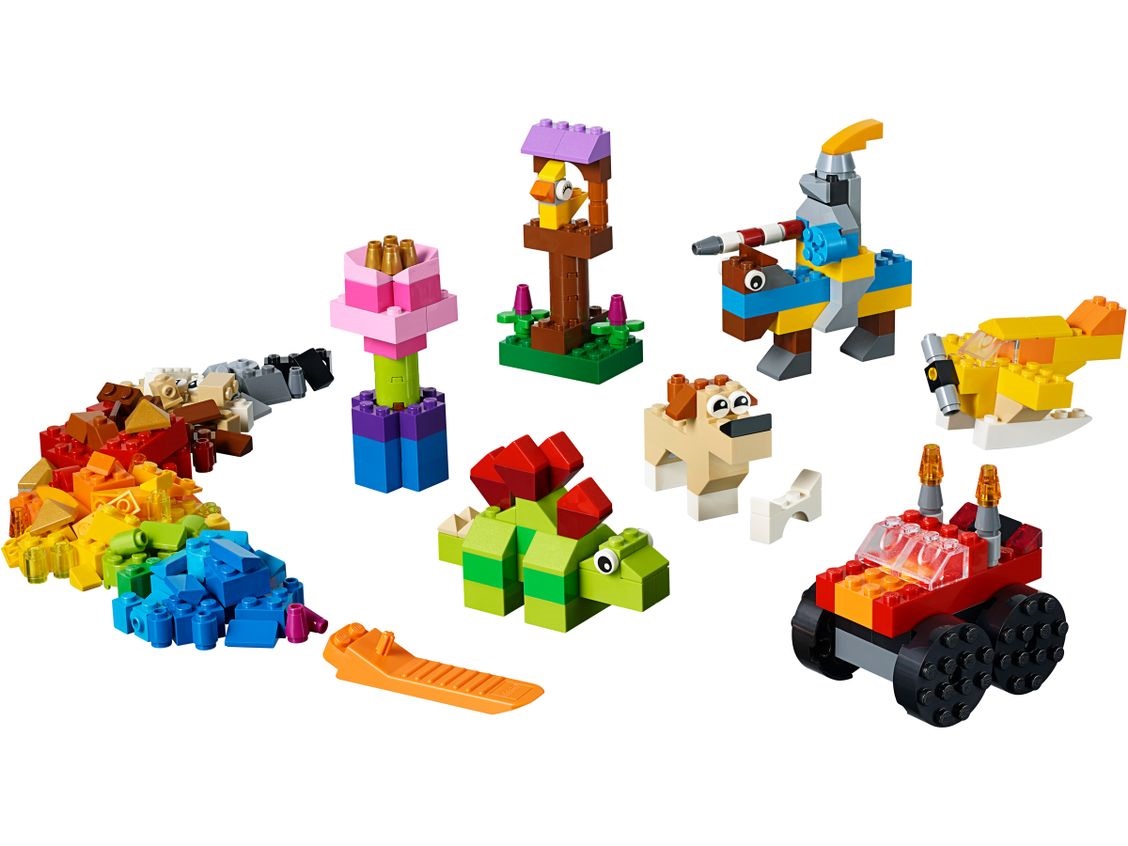
11003 LEGO® Bricks and Eyes
Bring LEGO® bricks to life with building instructions for these eye-catching toys. There are cute animals to build, plus a pirate, pet shop, helicopter and more. Simply download the free instructions and open kids’ eyes to the possibilities inside the LEGO Classic Bricks and eyes box!
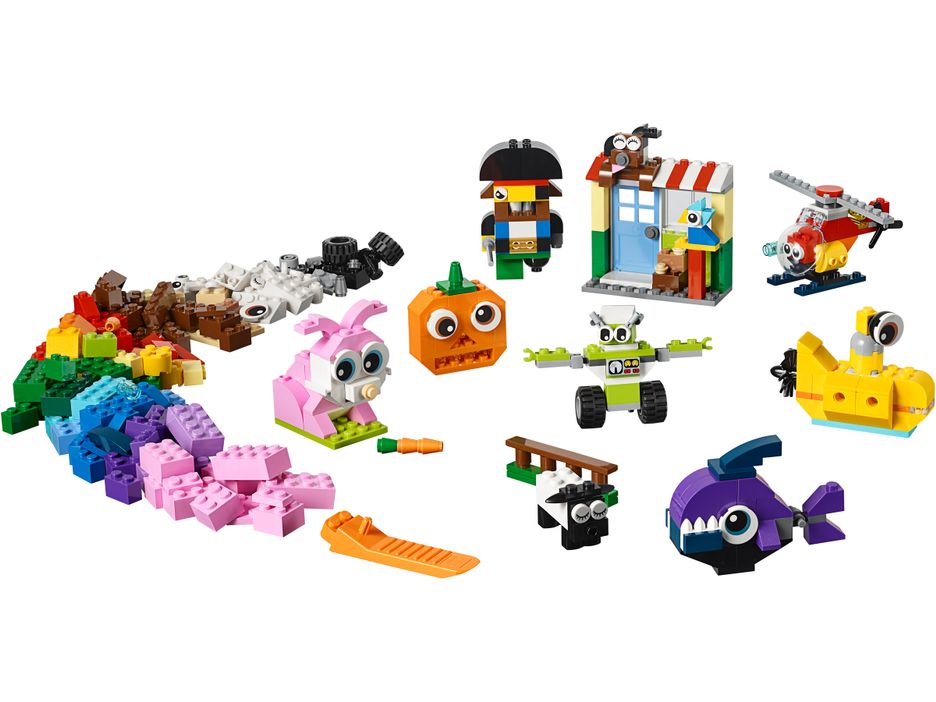
11005 LEGO® Creative Fun
Unlock kids’ creative potential with free LEGO® building instructions. These simple guides give young builders what they need to explore an imaginative world of cute animals, fun vehicles and cool LEGO toys.
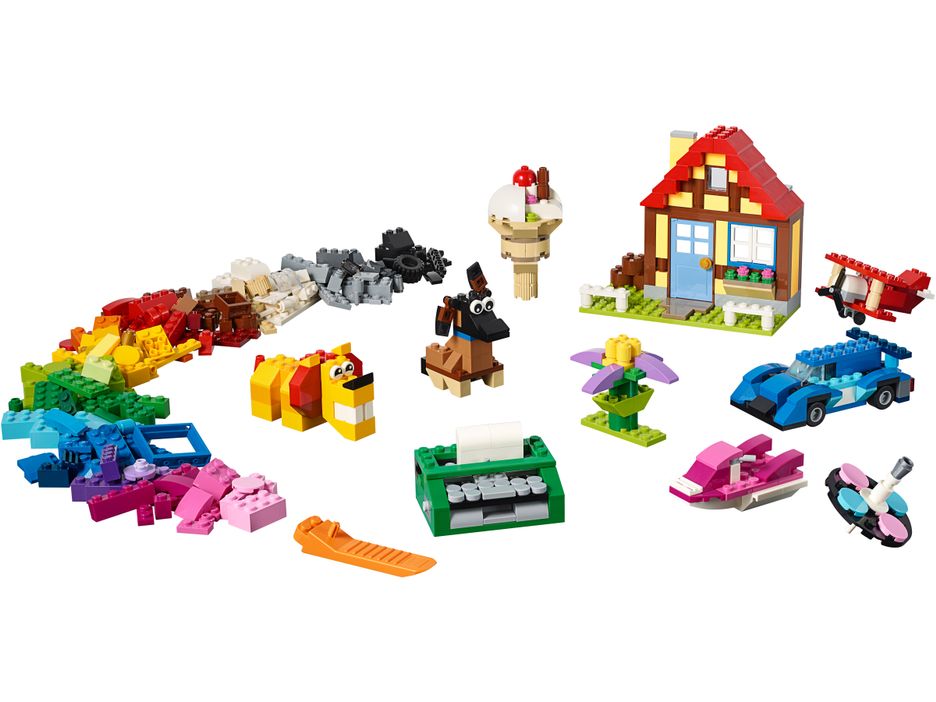
10717 LEGO® Bricks Bricks Bricks
Download free building instructions for LEGO® Classic Bricks, Bricks, Bricks – and watch kids build, build, build! With so many LEGO toys to create – from a castle to a jet fighter, a pirate’s galleon to a mom and baby elephant – the imaginative possibilities are endless!

10713 LEGO® Creative Suitcase
Inspire budding builders to explore their creativity with free building instructions – and they’ll soon transform this colorful collection of bricks into an airplane, robot, elephant, car, sailboat, fortress … then who knows where their imagination will take them!

10712 LEGO® Bricks and Gears
Help budding engineers make the most of their bricks and gears. Download your free building instructions and soon they’ll be creating a toy helicopter, turning windmill, monkey swing, a spinning carousel… and many more mechanical masterpieces!
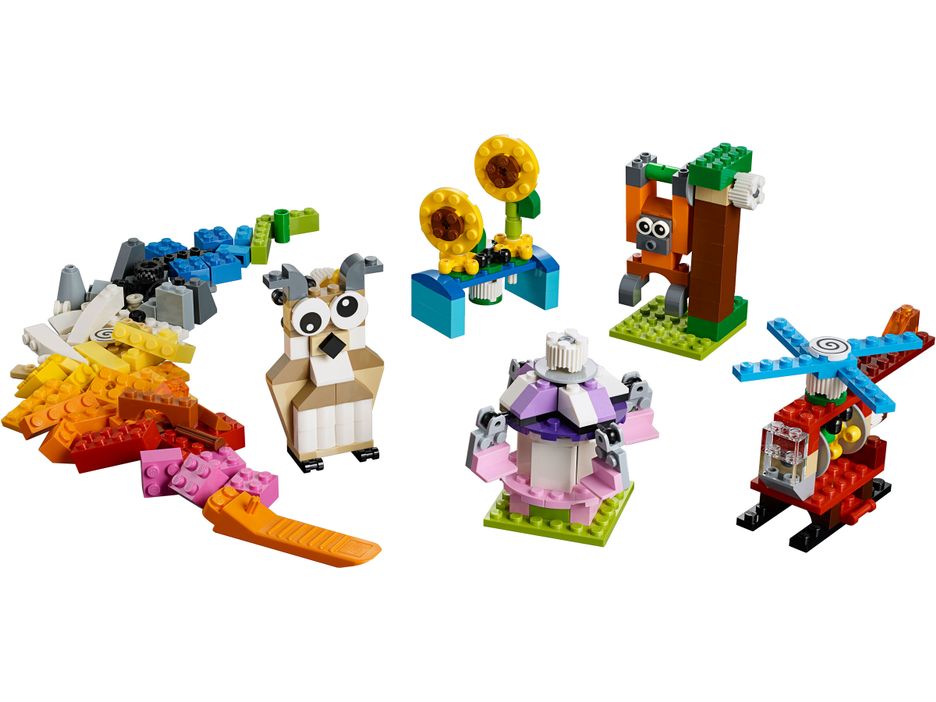
10715 LEGO® Bricks on a Roll
Download free building instructions for this dynamic LEGO® Classic box and get kids’ creativity moving! From a dog on a skateboard to a car pulling a caravan, a horse and cart to a motorbike – watch as they explore an imaginative world of wheel power!
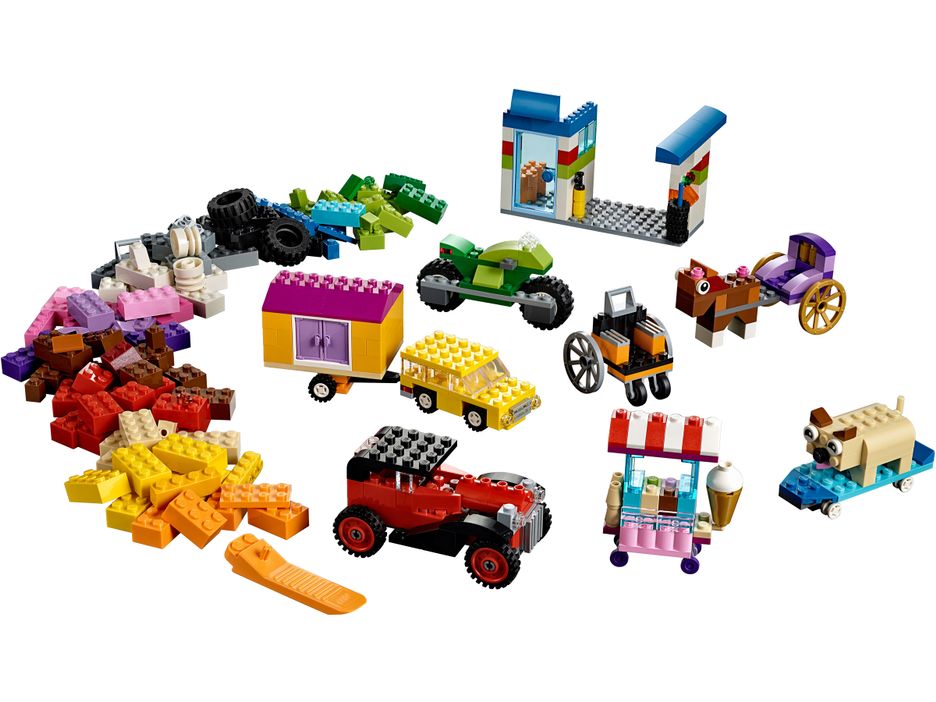
10696 LEGO® Medium Creative Brick Box
With a mad mix of bricks, windows, eyes and wheels, this LEGO® Classic set is bursting with creative possibilities. From a space shuttle to a windmill, a toaster to a tiger, these awesome quick-build models are a great way to get started. Download your free building instructions now.

10698 LEGO® Large Creative Brick Box
Download free building instructions and celebrate Christmas and other public holidays with buildable LEGO® toys! And that’s not all, there’s a camera, teddy bear, excavator, castle, locomotive… enough quick-build LEGO creativity to keep kids busy all year long!
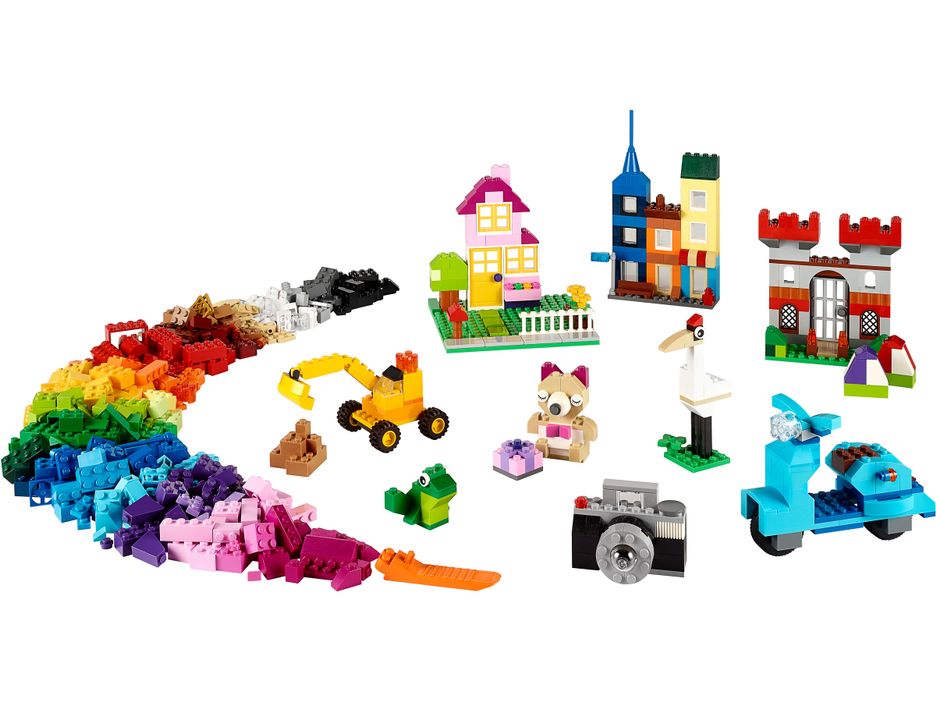
10692 LEGO® Creative Bricks
Inside this LEGO® Classic box is a world of make-believe! Download free building instructions now – and soon your little LEGO builder will be visiting a lighthouse, flying a propeller plane, shopping at the grocery store, feeding a cow…
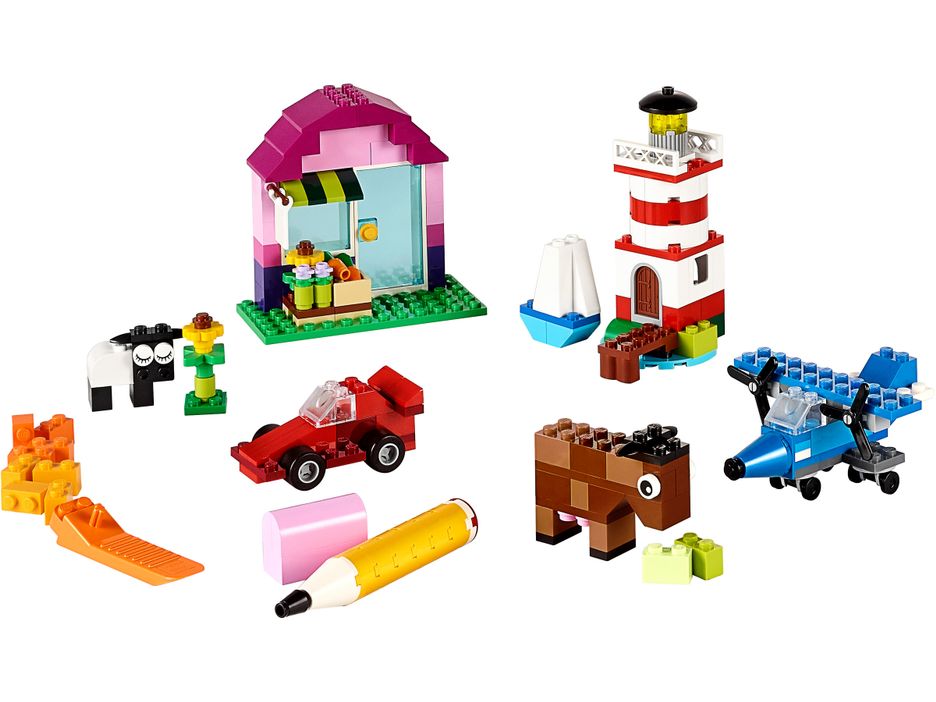
10693 LEGO® Creative Supplement
Give budding LEGO® builders a great start with these awesome quick-build LEGO toys. There’s a dinosaur toy, robot, shark, pirate ship, jet airplane, a rocket… Simply download the free building instructions and watch kids’ imaginations soar!
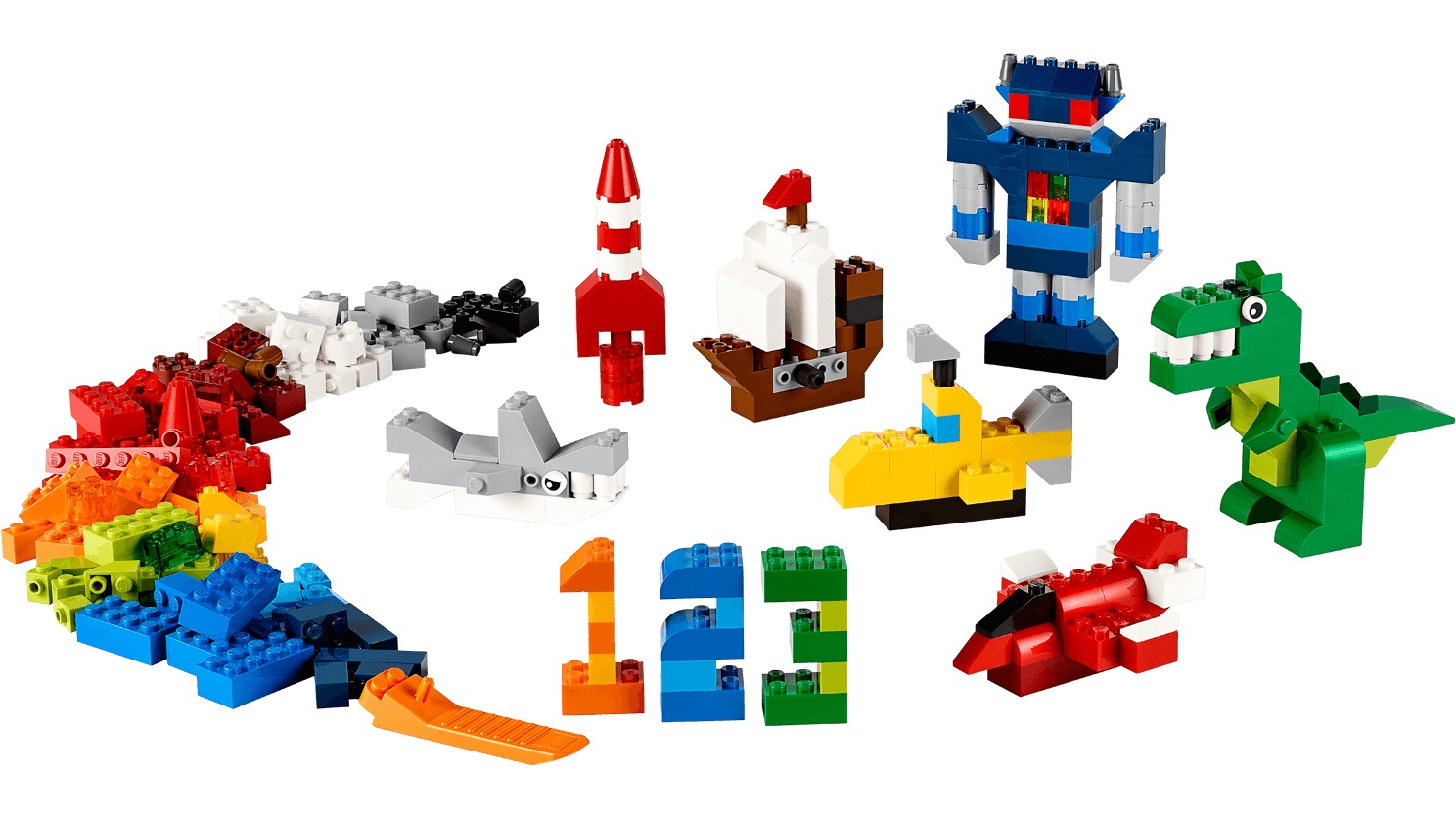
10694 LEGO® Creative Supplement Bright
Bring these pretty pastel-colored LEGO® bricks to life with simple building guides that are free to download. From a butterfly to a birdhouse, a rabbit to a birthday cake, these imaginative creations will inspire endless creative play.
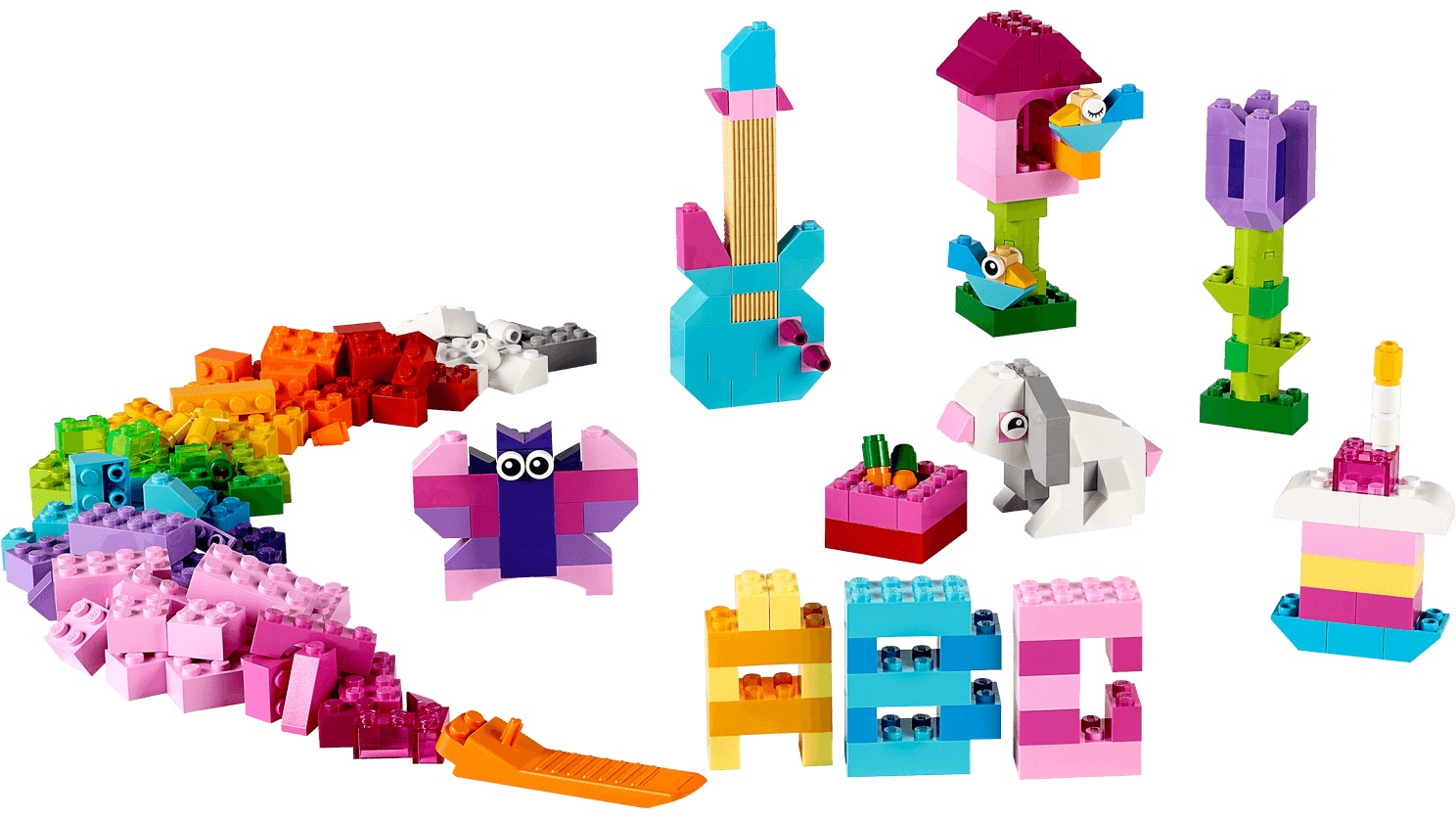
10703 LEGO® Creative Builder Box
Building instructions for budding architects! Download the free guides to help kids construct a castle, skyscraper, hotel, take a trip to the store, or an Asian temple, then return home to a cute yellow house.
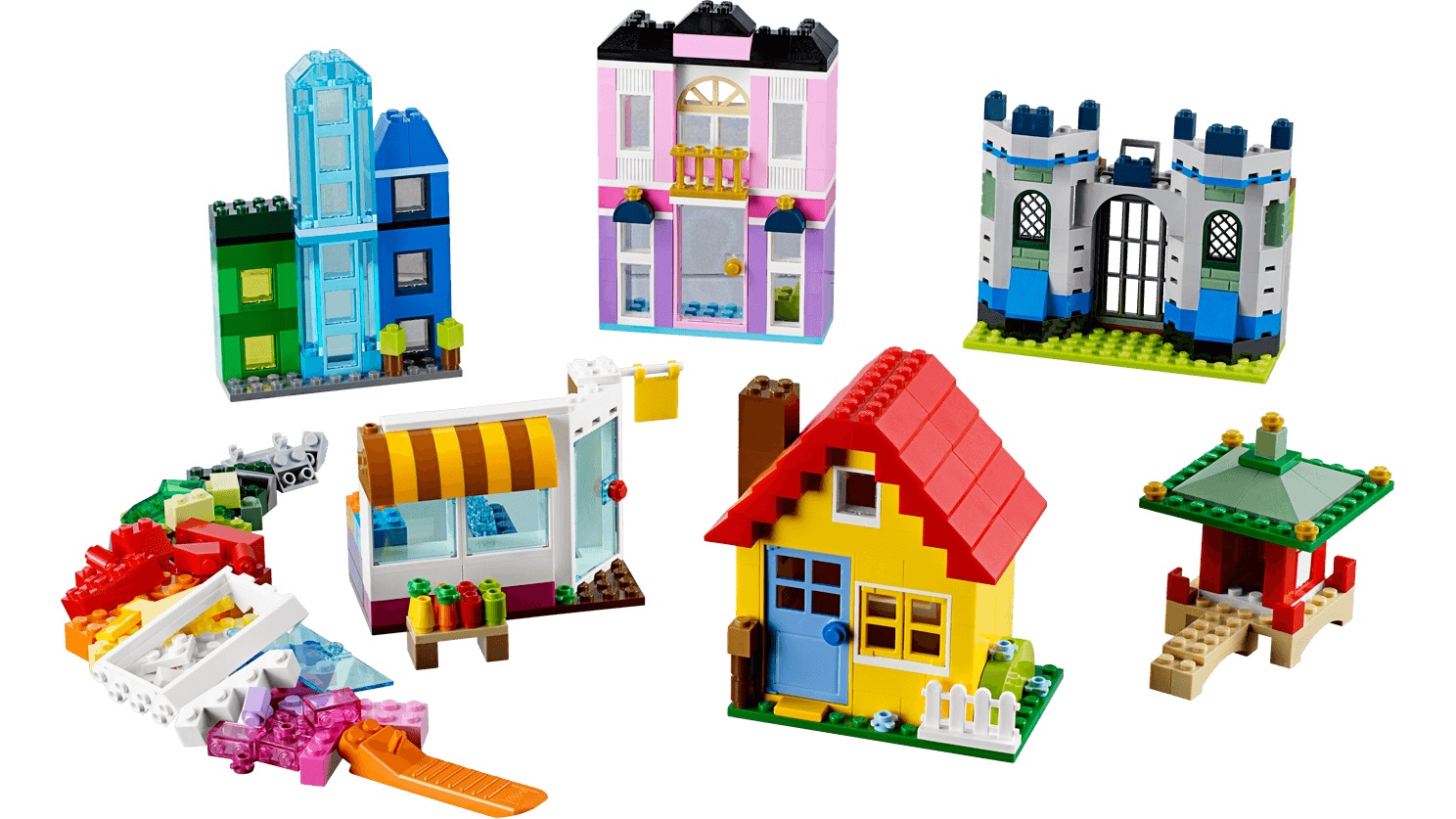
10704 LEGO® Creative Box
Help kids turn this exciting collection of colorful LEGO® bricks into a sailing boat, garbage truck, winter cabin, mobile phone, dragon kite, cute dog, tropical fish, toy car and a popsicle. Download your free easy-to-follow instructions now!
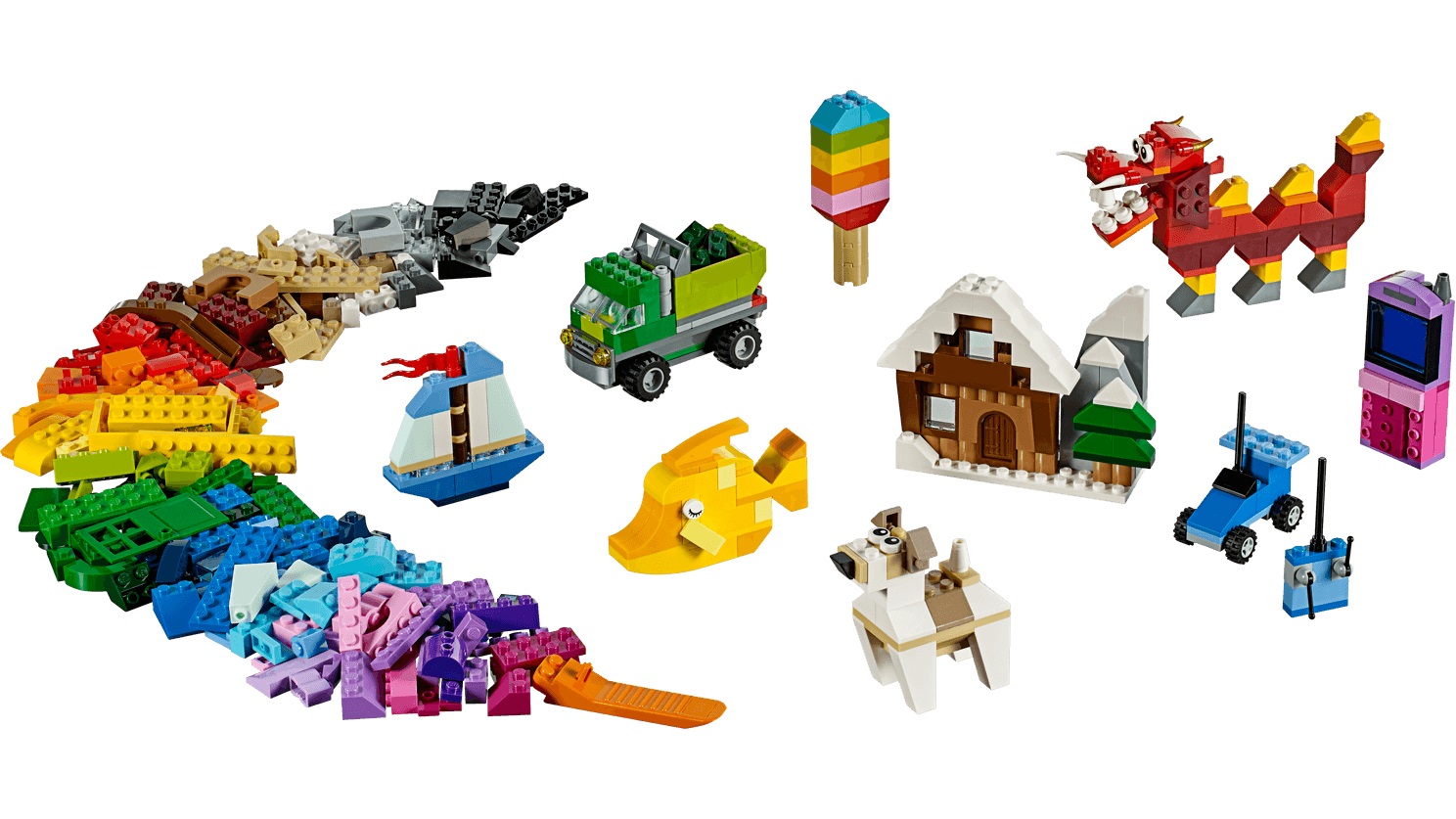
10706 LEGO® Blue Creativity Box
Introduce kids to creative LEGO® building with 3 blue-brick toys – a whale, train and a house – followed by endless free-building fun. Download the free building instructions now and watch your young builder’s imagination soar!
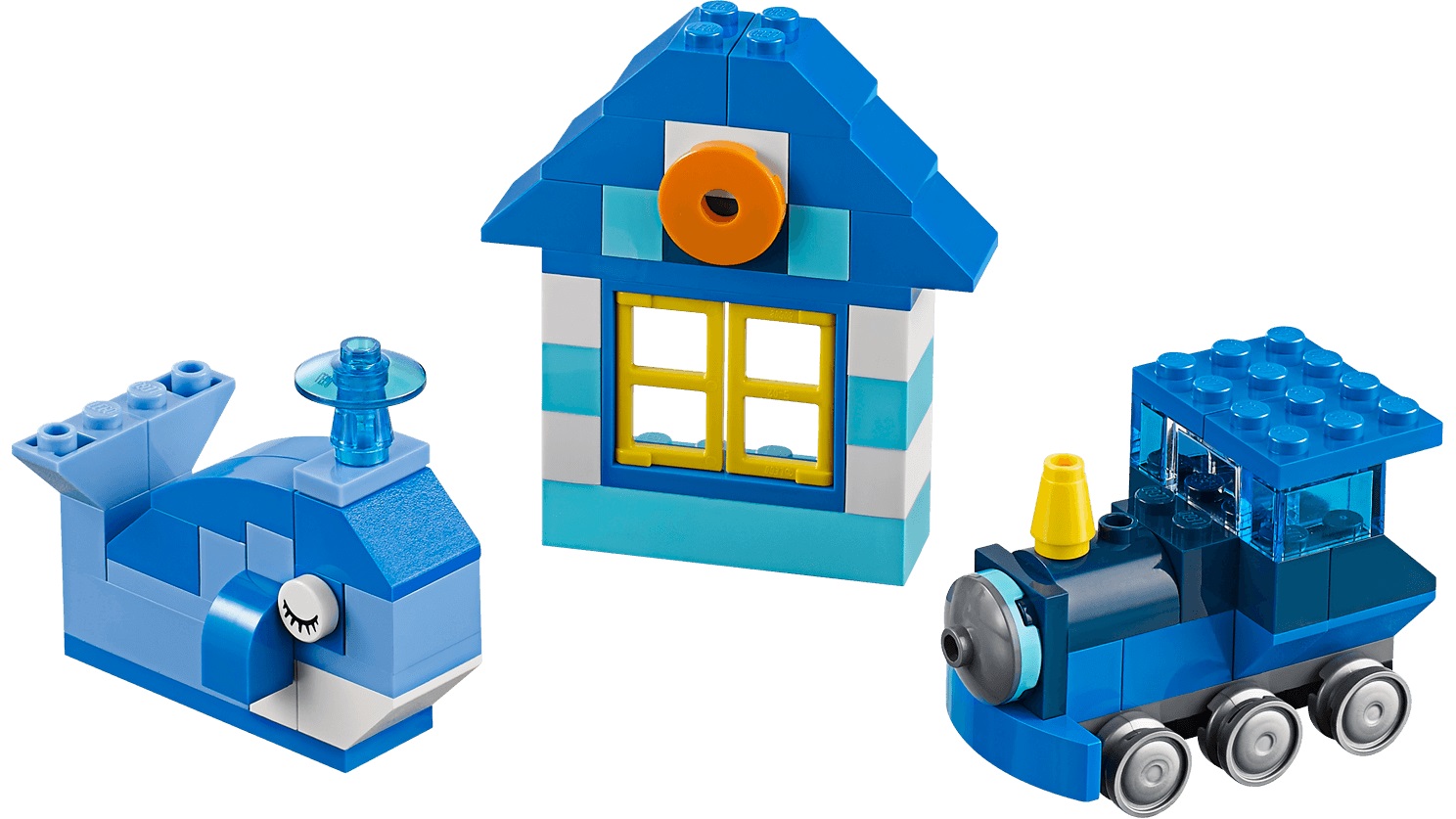
10707 LEGO® Red Creativity Box
Get young builders creating cool LEGO® toys straight from the box. Download free, simple guides to build this turning windmill, push-along racing car and cute grabbing crab. Once they start building, the open-ended creative play will never stop!
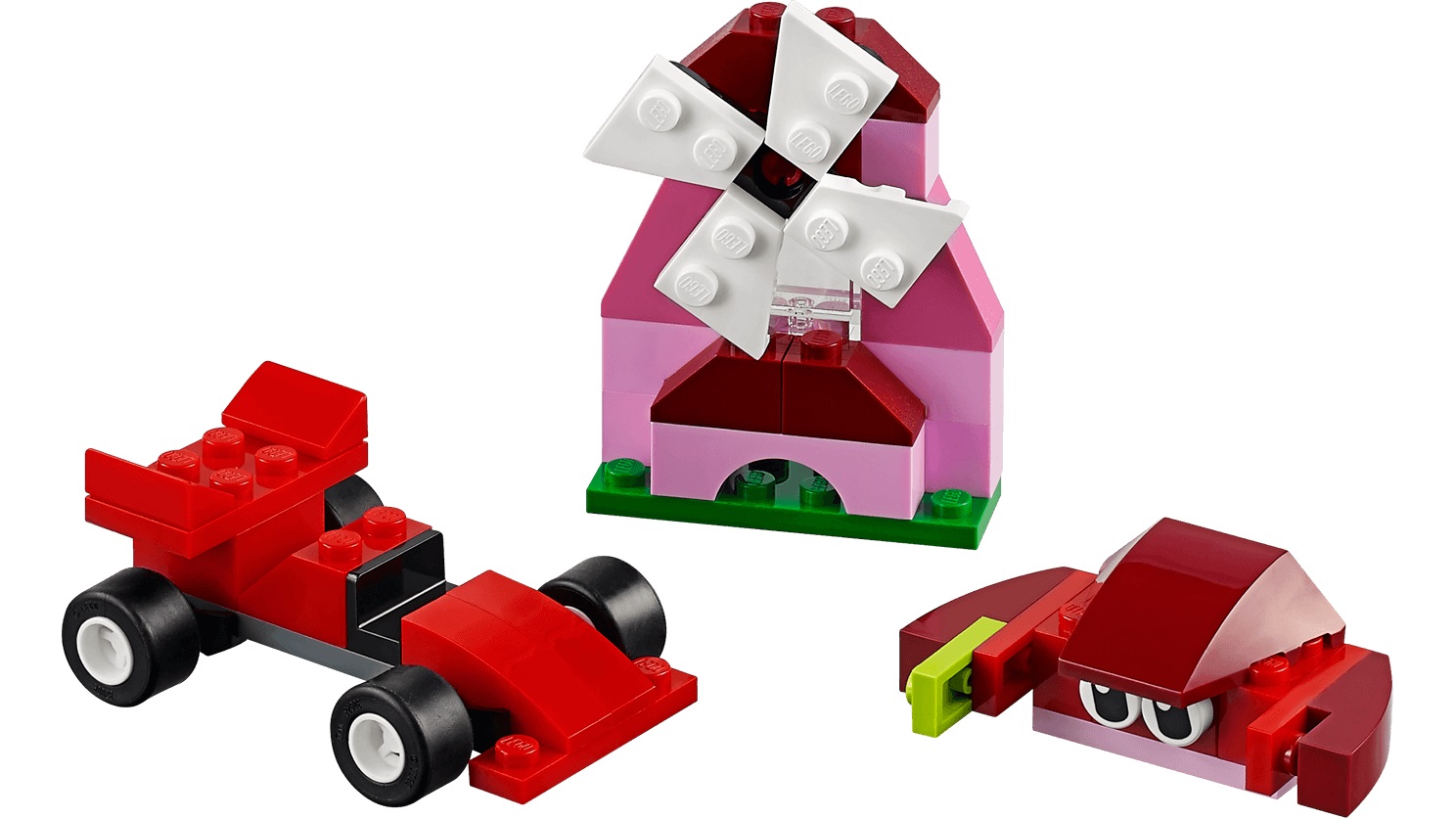
10708 LEGO® Green Creativity Box
Download your free building instructions for this LEGO® Classic Green Creativity Set. With 3 fun brick toys to build – a big-toothed crocodile, push-along tractor and a cool castle –it’ll be ‘green for go’ for kids’ imaginative play!
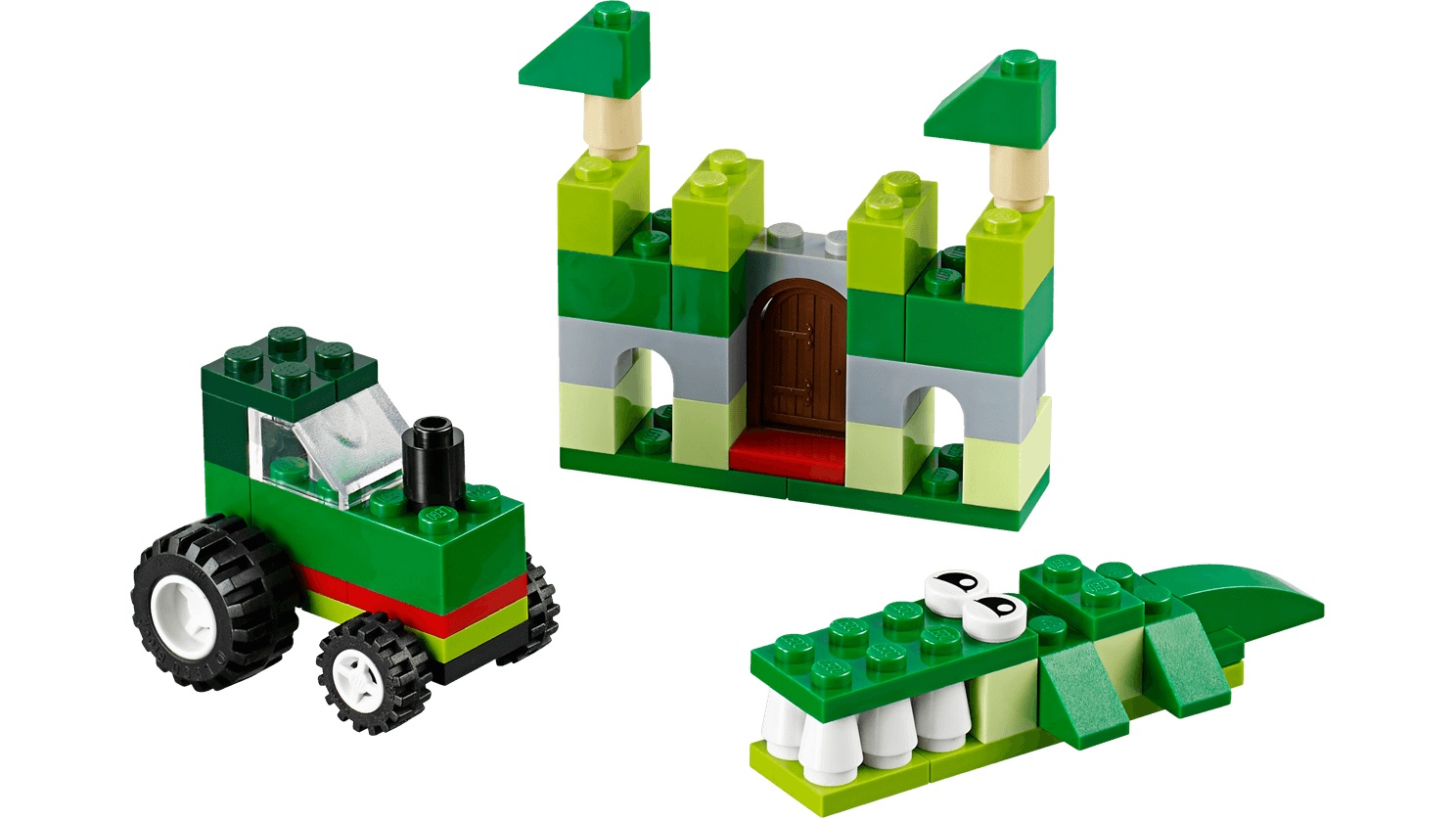
10709 LEGO® Orange Creativity Box
You’ll be amazed how creative kids get when you download free building instructions for this awesome mix of orange LEGO® bricks. In no time at all, they’ll be role-playing at their own juice bar, taking a flight in a propeller plane and stroking a friendly lion.

About Us
Support
Attractions
More From Us
About Us
Support
Attractions
More From Us
LEGO System A/S, DK-7190 Billund, Denmark. Must be 18 years or older to purchase online. LEGO, the LEGO logo, the Minifigure, DUPLO, LEGENDS OF CHIMA, NINJAGO, BIONICLE, MINDSTORMS and MIXELS are trademarks and copyrights of the LEGO Group. ©2022 The LEGO Group. All rights reserved. Use of this site signifies your agreement to the Terms of Use.
Lego has built the childhoods of many children, helping them bring their ideas into fruition.

You are almost certain to have some experience with Lego at some point during your childhood, or perhaps as a parent. Those small, colorful plastic bricks have helped tons of small children take their imaginative ideas and bring them to life. If you have ever played with Lego bricks, you are sure to have appreciated their creative uses. But, how much do you know about your beloved childhood bricks?
Build a world with your imagination
Without giving you too lengthy a history lesson, the LEGO group was founded in 1932 by Ole Kirk Kristiansen. What started off as a humble toy company has today turned into one of the most famous and beloved toy manufacturers in the world. "Inspiring and developing the builders of tomorrow," the company has transcended toys to become the perfect tool for anyone looking to create and play. From grand monuments to your latest take on a car, there is nothing you cannot create with a set of Legos.
If you are a Lego fan, or simply curious about the plastic brick, here are some facts about the beloved bricks.
1. Lego makes more tires than Goodyear

Though it might seem like a silly myth, this here is a fact. On average, LEGO produces a whopping 318 million plastic tires a year, making that approximately 870,000 mini-tires a day. The Lego company produces these tires 24 hours a day, 365 days a year.
2. You can pitch your own lego set

For those part of the Lego community interested in creating their own Lego set, if you share your idea on their page and your idea gets 10,000 likes, the company will consider the possibility of bringing it to toy shelves.
3. The Lego mini-figures are yellow for a reason

When the Lego Minifigure was introduced in 1975, the company wanted the builders to project their imaginations onto faceless figures. Yellow was believed to be a racially-neutral color. Although today, they do come in other colors.
4. Artists love using Lego bricks to create inspiring work

As you probably already know, Lego bricks are not just for kids. Countless artists, sculptors, and painters have incorporated Lego into their works, creating imaginative and playful pieces.
5. Lego bricks from 1958 can still 'connect'
If you found a Lego piece from the 1950s lying around, it would be able to connect with a Lego from 2020. Lego bricks are part of a universal system, meaning no matter when they are made, the pieces will always be compatible.
6. The biggest and most expensive commercial Lego set comes from the Star Wars universe

This highly sought after Ultimate Collectors Series Millennium Falcon set contains more than 7,541 pieces and costs around $800. It might take you quite a while to build this set. That's right, you can finally get your hands on the Millenium Falcon.
7. There is a house entirely made of Lego bricks

Have you ever dreamed of building your home out of Lego bricks? Well, someone has actually gone ahead and done this. Using more than three million bricks, the BBC documented the building of a mostly functional home for the show James May’s Toy Stories. The house used more than 3 million bricks and included, "a working toilet, hot shower and a very uncomfortable bed".
8. The World's highest Lego tower contains over 500,000 bricks

A team of ambitious builders decided to build a 112-foot tower out of Lego bricks. The summer-long project landed them in the Guinness Book of World Records.
9. Numbers inside each Lego brick tell a story
The number on the underside of your bricks corresponds to the precise mold that was used to form the brick before it was placed in packaging. If there are any defects, Lego can trace the issue back to its origins.
10. This kid created a braille printer with his Lego set

Shubham Banerjee used the Lego Mindstorms set to create a fully operational Braille printer for the blind. Banerjee is the evangelist/founder of Braigo Labs Inc. Using Intel Edison Technology, his Lego project was borne out of the ambitious goal to help 200 million blind people.
11. The Lego name is special
Where did the Lego name come from? It is actually a lot more simple than you think. The word Lego was created by using the first two letters of the Danish words “Leg” and “Godt,” meaning “play well.” Interestingly, Lego is not a noun, it is an adjective, as in Lego bricks, Lego products, and Lego set. Have you been using the word correctly? Oh, and the plural of the word is also "Lego."
12. There are a lot of Legos out there in the world, and they are extremely sturdy

Did you know that there are around 400 billion Lego bricks around the world? If you were to stack all of these Legos together, this tower would 2,386,065 miles (3,839,999 kilometers) tall — meaning that it would stretch ten times farther than the distance to the moon. Even more so, Legos are extremely sturdy. One LEGO can take up to 4,240 Newtons of force, or over 953 pounds. Maybe we should build more structures with Legos?
13. Your Legos will never decompose
Your Legos will probably outlast you. literally. Legos are made from ABS plastic. Acrylonitrile butadiene styrene (ABS) is a common thermoplastic polymer. Because of its properties, you would need extreme temperatures or large amounts of UV light to begin the degradation process. This thermoplastic is also commonly used in 3D printing. Because of this, Lego is working on ways to reduce the environmental footprint of the bricks.
14. You only need a few Legos and a wild imagination

In 2014, Lego passed Hasbro to become the world's second-biggest toymaker, behind Mattel — the creators of Barbie, and Hot Wheels. If you have not figured it out already, people love Legos, and you do not need many to get started.
Mathematician Søren Eilers devised a computer program to determine the number of possible structures you could make using just six standard (4x2) Lego bricks. The answer was an astounding 915,103,765. On average, children spend 5 billion hours a year playing with Legos.
15. Who invented Legos?
As we have already mentioned, Ole Kirk Christiansen created the Lego brick in 1932. However, he didn't invent the first self-locking bricks. A British man named Hilary Fisher Page (1904-1957) invented a self-locking brick that was a predecessor to Lego. The Lego bricks were based on these. The first Lego blocks were patented in 1949.
Check out these amazing 15+ LEGO scupltures from around the world.

The only limit to what you can build out of LEGO blocks is your imagination. To fully illustrate this, we've found 15 of the best sculptures made with LEGO bricks out there. Some of these are absolutely incredible and actually hold some world records.
The following list of incredible LEGO projects is far from exhaustive and is in no particular order.
1. This is the tallest LEGO structure (tower) in the world

Amount of LEGO pieces used: 500,000 +
Location: Tel Aviv, Israel
This incredible LEGO build is the tallest LEGO tower structure (it's yet to be confirmed) in the world. It stands at 19.6 ft (35.95 meters) tall.
Although claimed to be the tallest tower, the current official record holder is in Milan, Italy. Fittingly, the tower is actually named after him and is an incredible feat of LEGO-building.
2. LEGOland decided to swap a real Volvo car for a LEGO sculpture, just for kicks

Amount of LEGO pieces used: 200,000 +
Location: California, U.S.
In 2011, LEGOland decided to play a prank on their unsuspecting General Manager by swapping their real Volvo XC60 for a near-perfect LEGO sculpture replica of a Volvo XC90. He was amazed to return to his beloved transport to find that it had been replaced with a lifesize scale LEGO model.
The incredibly detailed model is a true work of art and weighed in at a whopping 1 tonne. It was so heavy it required the use of a forklift truck to put it into place.
3. This artist actually creates pieces of art using LEGO bricks

Amount of LEGO pieces used: Varies but the largest (Mona Lisa) consumed 30,000 bricks
Location: Eric Harshbarger is based in Alabama in the U.S.
Artist Eric Harshbarger creates amazing mosaics and other pieces of artwork using his skill and LEGO pieces alone. As if this isn't specialized enough, he focuses on recreating famous works of art in LEGO form.
His largest work to date, the Mona Lisa, used only six basic colors to create. Eric has an enormous portfolio of amazing LEGO mosaics, LEGO sculptures, and many more. You can even commission him to build one for you.
4. This Tower Bridge replica is a Guinness World Record Winning LEGO structure

Amount of LEGO pieces used: Roughly 6 million bricks (5,805,846)
Build duration: 1 year
Location: Paddington Hall, United Kingdom
In 2016 Landrover approached Bright Bricks to create the largest LEGO sculpture ever attempted. But wait, there's more.
The proposal was to build a replica model of Tower Bridge and they wanted to be able to drive a Land Rover Discovery over the structure when completed.
It took the team many millions of bricks, 1 year, and a hell of a lot of hard work to complete the structure. For their efforts, the team was rightfully awarded the Guinness World Record for the largest LEGO sculpture.
5. This futuristic LEGO map of Japan is incredible

Amount of LEGO pieces used: 1.8 million bricks
Location: Japan
5,000 Japanese students in six different workshops managed to build an incredible futuristic map of Japan. So-called Project Build-up Japan was sponsored by LEGO to celebrate its 50th-year presence in Japan.
It's not an exact replica of Japan but more of a conceptual model for the possible future topography of the nation. Built almost entirely out of ivory colored blocks, it is an eerily beautiful prediction of the future.
6. These incredibly spooky houses are a sight to behold

Amount of LEGO pieces used: Varies but some use as many as 130,000 bricks
Build duration: Varies but 'Three-storey Victorian with Tree' took 450 hours to build
Location: N/A
Mike Doyle is an incredible LEGO sculptor who builds incredibly realistic models of Victorian-style houses that are absolutely stunning in their attention to detail. Each of his abandoned houses is meant to represent nature's ability to ruin anything a man can build.
It's amazing to think that each and every one of his abandoned house sculptures are made exclusively out of plastic LEGO bricks.
7. This school has one of its wall clad in LEGO!

Amount of LEGO pieces used: 1,263,801
Location: Cowley St. Laurence Church of England Primary School and Children’s Centre in Hillingdon, Greater London
The architects for the Cowley St. Laurence CoE Primary School wanted the school's children to take part in the design of their school. They decided to recruit children, parents, and teachers to help build one facade of the building out of LEGO bricks.
The final result is 2,690 ft 2 ( 250 m 2 )of LEGO awesomeness that has a patent-pending for the LEGO build process used.
8. This sculpture holds the Guinness World Record for the largest LEGO ship

Amount of LEGO pieces used: 2.5 Million bricks +
Build duration: 2 months by more than 1,000 builders
Location: Hong Kong
The entire model weighs 2.8 tonnes and measures 27 ft (8.44 m) long, 4.36 ft (1.33 m) wide, and 5 ft (1.53 m) tall.
9. This LEGO Mario is super awesome

Amount of LEGO pieces used: 30,000 +
Build duration: 160 Hours +
Location: The Netherlands
This giant LEGO statue of Mario is both awe-inspiring and has brought some good to the world. It was sold to raise funds for the Ronald McDonald Foundation in the Netherlands back in 2009 for around $3,700.
This charity raises money to supply proper housing for relatives of hospitalized children, in the vicinity of clinics.
10. This giant LEGO robot sculpture is awe-inspiring

Amount of LEGO pieces used: 2.8 Million Bricks
Location: Minnesota Mall of America
Called Herobot Nine Thousand, this robot sculpture is one of the most impressive LEGO structures of all time. It stands at about 38ft (11.6 meters) and weighing in at 6 tons it's a real testament to the talent of its builders.
Frankly, you'd be amazed it isn't the 'Real McCoy'.
11. This Life-size LEGO house is the dream home for any LEGO-lover

Amount of LEGO pieces used: 3.3 Million Bricks
Location: Denbies Wine Estate in Dorking, Surrey (Formerly)
This incredible life-size LEGO house took 1,000 volunteers to build the 19.6 ft (6 meter) tall house. James May, of Top Gear fame, helped organize the construction with the help of 1,000 volunteer builders.
Although not entirely practical as a home it was situated in the middle of a vineyard. Despite this, it was later demolished as no buyer could be found, but hey, it did have a working toilet and shower and its own LEGO key.
The bricks were given away to charity following the building's demolition.
12. This giant LEGO Pharoah is truly incredible

Amount of LEGO pieces used: 200,000 +
Build duration: 5 Months
Location: Legoland Windsor, Windsor, UK
Weighing more than 1 ton this giant LEGO Pharaoh was made in the Czech Republic but has since found its home in the UK. To make this journey, it was transported by truck and floated down the Thames.
It was commissioned to be part of a new £3 Million attraction at LEGOland Windsor to form part of the Kingdom of the Pharoah's display at the park. It took four modelers only five months to complete and traveled over 1394 miles (2245 km) from the Czech Republic.
13. This model of the USS Intrepid is a LEGO builder's fantasy

Amount of LEGO pieces used: 250,000 +
Build duration: 600 hours
Location: Artist lives in Portsmouth, UK
This cool LEGO build is one of the biggest, and most impressive, LEGO ships ever made. Built at a scale of 1:40, it's as close to the actual famous WW2 aircraft carrier as it gets.
Built by LEGO artist and enthusiast David Dement, it measures in at over 21 ft (6.7 meters) and was inspired by his trip to the real one. It is complete with movable gun turrets, scale-model aircraft, and even crew escape rafts.
Not only that but David built a working elevator from the main hanger to the main deck.
14. This 1:1 scale LEGO model of an X-Wing is truly out of this world

Amount of LEGO pieces used: 5.3 Million Bricks +
Build duration: 17,366 hours
Location: Artist lives in Portsmouth, UK
Coming complete with a life-size model of R2 D2, this full-scale LEGO sculpture X-Wing has a total wingspan of just over 32 ft (10 meters). What's more, the engines can even light up and roar.
The entire construction weighs 20.8 tonnes. It is 11 ft (3.35 meters) tall, 43 ft (13.1 m) long, and took 32 builders around 4 months to finish.
In theory (if you can get permission), you could even sit inside the cockpit and re-live your childhood ambitions of being Luke Skywalker or Biggs Darklighter (who are we kidding?).
15. These shadow art LEGO sculptures need to be seen to be believed
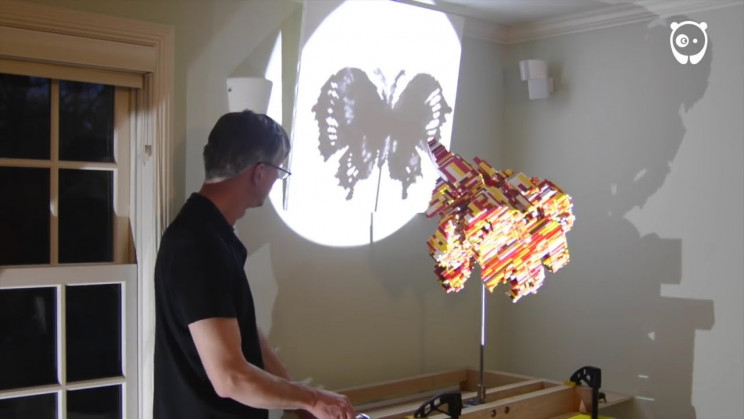
Amount of LEGO pieces used: Varies but some as many as 41,000 bricks
Location: Artist lives in Chicago
Artist John V. Muntean is an incredible LEGO builder who makes models whose actual form is only realized once the model is backlit. His 'Magic Angle Sculptures' are a truly unique and fascinating use of these humble little plastic building blocks.
Each model uses light and movement to change the apparent amorphous masses of plastic into beautifully detailed shadow art. Some even contain three or more different images depending on the orientation of the model to the light source.
BONUS - Nathan Sawaya is an incredible LEGO sculptor

Amount of LEGO pieces used: Varies but "Yellow" consumed 11,014 bricks. "Rebirth of New Orleans" consumed an amazing 120,000 + bricks.
Build duration: Varies, but usually days. "Rebirth of New Orleans" took several weeks.
Location: Artist lives in New York City
Nathan Sawaya is a truly incredible LEGO artist. He specializes in creating human sculptures out of LEGO and each one of his creations starts out with a hand-drawn concept. He is probably best known for his work "Yellow" which represents his move from the corporate world to a LEGO artist.
Another one of his famous works is the "Rebirth of New Orleans", which was commissioned to commemorate the rebirth of the city after the devastation of Hurricane Katrina.


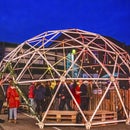

About: I'm an industrial designer, living in a FabLab. I like 3D modeling and printing, lasercutting, Arduino, and frankly any form of prototyping. More About OOTUS »
In this step by step tutorial I am going to show you how to design a parametric Lego brick in Fusion 360.
The main goal is to create one design that could immediately generate all kinds of different Lego bricks just by entering 3 parameters: a length, a width and a height.
I used Fusion 360 to create this parametric design, you can download this 3D CAD software for free as long as you are using it as a hobbyist.
Step 1: How Do Lego Units Work?
The 3 parameters we will use to dimension our Lego brick, will be entered in Lego units.
Lego units work as follows:
- 1 unit has a length and width of 8 millimeters
- The height is 3,2 millimeters for the low bricks and 9,6 millimeters for the high ones. This causes 3 low bricks to have the same height as one high brick.
- There is a 0,2 mm clearance spacing to make sure that 2 adjacent blocks fit together easily.
So the determination of the height of our brick is easy, it wil be either in the "LOW" state (3,2 mm) or in the "HIGH" state. Defining the width and length of a brick however is a little bit trickier. We are going to design a brick that is 4 units long and 2 units wide as an example. This block will be 4 times 8mm long, minus the clearance spacing of 0,2mm, thus its total length will be 31,8mm. Same goes for the width which will be 2 times 8mm long, minus the spacing, which results in a total width of 15,8mm.
Step 2: Parameters in Fusion 360
We are going to start by entering these parameters into Fusion 360, then we can always reference them throughout the entire design process.
So first of all we’ll go to “Modify” and then “Change Parameters” and here we can add our first parameter by clicking the green plus icon next to “User Parameters”. We’ll give it a name “LENGTH” and set the units to “no units” because the Lego units are always whole numbers. Then we can do the same for the “WIDTH”. And we will set these to 4 and 2 for now, but we can always change this later on of course. And lastly we can enter the “HEIGHT” parameter which will be in millimeters and will have a value of 9,6 for the high state and 3,2 for the low state.
We can also make a parameter for each of these states so in the end we can just set the “HEIGHT” parameter to “HIGH” or “LOW” without having to worry about the actual dimensions. Note that you can also reference parameters to each other, so we might as well just change the value of the high state to 3 times the low state.
Step 3: Designing the Actual Brick
We will start by drawing the outer dimensions of the brick itself.
So first of all we willl sketch a center rectangle, we can do this in the top view, and put its center on the origin. We dial in the correct dimensions afterwards with the (sketch) dimensions command. The short side of our rectangle equals the “WIDTH” parameter multiplied by a length of 1 Lego unit, thus 8mm, and minus the clearance of 0.2 of a millimeter. The long side dimension equals the “LENGTH” parameter also multiplied by 8mm and minus the clearance. Don’t forget to finish the sketch by clicking the “stop sketch” icon on the top.
Next up we can extrude this sketch by going to “Create” and then “Extrude”, we can select the profile we’ve drawn and dial in a distance which equals the parameter “HEIGHT”. Now we have a brick with the overall outer dimensions, this is a good moment to play around a little bit with our 3 parameters to make sure that everything is working correctly and we haven’t made any mistakes. If we did make any, we would be better off fixing them straight away, because even small problems now can lead to bigger problems later.
Step 4: Add the Studs
The next step is making the studs on top of our brick. We’ll draw 1 stud first and copy the rest in a pattern afterwards.
We add a new sketch on top of our brick, draw a circle with a diameter of 4.8mm and add two dimensions to make sure that there is 3.9mm between the edges of the brick and the center of the circle. We extrude this circle for 1.8mm and that concludes it for the first stud. Because all the dimensions of this one stud are fixed it should always stay perfectly in the corner even when the parameters are changed.
We can now create a pattern to copy the rest of the studs. This is done by going to “Create”, “Pattern” and then “Rectangular Pattern”. We can then change the “Pattern Type” to “Features”, because the stud is just one feature that we are trying to copy, in this case an extrusion. And we can select this feature in the timeline history on the bottom. We can select 2 edges of our brick to set the correct “Directions” for our pattern, just make sure that you choose 1 edge running parallel with the direction of the width of the brick and another one running perpendicular to this first line for the length of the brick. “Distance Type” should be set to “Spacing”. When we dial in a distance of 8mm now, all the studs will be spaced precisely 1 lego unit from each other, which is exactly what we want. The quantities in both directions match with our parameters “LENGTH” and “WIDTH”.
This is again a very good moment to try and change the parameters to make sure no mistakes were made. You might have the parameters for length and width swapped around in the pattern settings for example, which can create “flying” studs where you don’t need them and a lack of studs where you do. Make sure that everything is changing as desired before you move on to the next step.
Step 5: Adding the Features on the Inside of Our Brick
Now that the outside of the brick is finished, we can hollow it out and add the rest of the features on the inside.
This is easily achieved with the “Shell” function, you can find it under the “Modify” tab in the function browser. We just have to select the faces of our brick that we want to open up, in this case the bottom, and set the “Inside Thickness” value to 1.6mm.
Now we can add the last feature, being the hollow cylinders on the inside of the brick. For this we’ll make a sketch on the bottom plane. We draw 2 concentric circles on the bottom by going to “Sketch” > “Create Sketch” and selecting the bottom plane of the origin. Next we’ll sketch one circle “Sketch” > “Circle” > “Center Diameter Circle” and we’ll repeat this command for the second circle while making sure we select the center of the first circle as the center of the second, and this will automatically generate a constraint that will make sure both circles will stay concentric. Now we enter the dimensions of the inner circle, being 4.8mm, and outer circle, being 6.5mm. Finally we’ll add 2 dimensions of 7.9mm that will lock the center of the first of these cylinders in the correct place, regardless of what parameters we’ve chosen, much like we’ve done for the first stud on the top of the brick.
Then we can extrude this sketch upward. We’ll select “Create” > “Extrude” and select the ring shaped profile we’ve just drawn. Now we change the “Extent” option of the extrusion from “Distance” to “To Object” and we select the top side of our brick. This will make sure that the hollow cylinder always has the correct height, no matter if it’s in the “LOW” or the “HIGH” state. The last step is again creating a pattern for this feature, and this is done in exactly the same way as with the studs on the top. So we choose “Create”, “Pattern” and then “Rectangular Pattern” again. Change the “Pattern Type” to “Features” and select the extrusion we just made in the timeline history on the bottom and select the 2 side edges for the directions of our pattern. “Distance Type” should be set to “Spacing” and both distances should have a value of 1 Lego unit or 8mm. Lastly we have to set the quantities to “LENGTH” - 1 and “WIDTH” -1.
Step 6: Generate Whatever Brick You Want!
Our parametric Lego brick is now finished!
We can change the parameters again to make sure that everything is adapting well to the input changes. Be aware that there are always limits when you’re designing parametric things. So if you try to generate a brick that’s 100 by 100 Lego units, your computer might have a lot of trouble calculating this. And on the other side of the spectrum, when you try to generate a 1 by 1 brick the bottom cylinder will stay there. So if you’re generating a brick with a width of 1 unit you’re better off suppressing the extrusion of this cylinder in the timeline. This can be done by right-clicking it in the history at the bottom and choosing “Suppress”. When you generate a new brick afterwards, and you need them again you can simply “Unsuppress” this feature.
And that’s how you use Fusion 360 to make a design that allows you to generate all these different bricks immediately, just by entering 3 parameters.
Читайте также:

